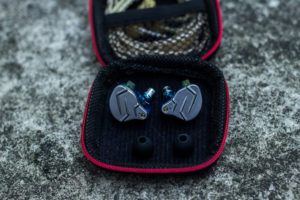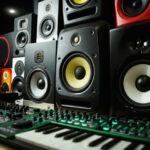In-ear monitors are one of the biggest modern technological developments within live music performance.
When performing on-stage the sound is outputted to the audience, away from the performers, which means without monitors the performer can often struggle to hear their own performance.
A monitor is a speaker that faces away from the audience towards the performer and allows them to not only hear their performance but decide which vocals or instruments they hear in their monitor and the level at which they can hear each channel.
Floor monitors require direct communication with a sound engineer to alter the levels to your specific requirements.
However, when playing in a large band or when moving around, floor monitors can be restricting as you have to be in front of the monitor to hear the audio.
In comparison, in-ear monitors allow performers to move around the stage and guarantee that the only monitor they hear is their own.
Also, floor monitors are limited in the sense that they are controlled by the sound engineer, in-ear monitors mean that you can control volume levels on your own without having to shout and signal at the sound engineer to ‘Turn me up!’ What’s more is that in-ear monitors completely eliminate feedback, which will make your sound engineer happy as well as the performer.
So whether you want to keep a keen ear on your own performance, or you just want to walk into the middle of the crowd and crank that guitar solo, in-ear monitors are the purchase for you.
Unless you’re a sound engineer, knowing the right tech to buy can be a confusing and patronising experience.
Below, I’ve laid out the best in-ear monitors on the market and simplified the jargon-filled world of sound into the most important features you need to get back to performing as soon as possible, armed with the best gear on the market.
In-Ear Monitor Systems
OUR TOP PICK
Shure is renowned amongst sound technicians as one of the highest quality brands when it comes to monitors and general sound gear, especially for an entry-level in-ear monitor. This in-ear monitor system is one you can trust to do the job.
Pros
- The receiver is metal, durable, and lightweight. These are the qualities you will notice when performing, you don’t want to feel like the receiver is on your body at all, nor do you want to accidentally break it when setting up your gear.
- Shure is known for its in-ear headphones so the ones that come with the system are of high grade and fit well.
Cons
- The frequency band is 488MHz-512MHz which translates to around 300ft. This certainly isn’t the biggest frequency band on the in-ear monitor market but is likely to fit the needs of most performers.
- The receiver doesn’t have an LCD display on it, like other systems, which can cause problems when you want accurate information on levels etc.
EDITORS CHOICE
Phenyx is another home-brand when it comes to sound engineering. The PTM-10 provides the performer with more accurate information on levels etc. than other brands.
Pros
- Bright LCD display that is easily readable in the dark, which is important when performing on what is often a dark stage.
- The receiver also has an LCD display which allows you to keep a keen eye on volume levels and channels.
- The PTM-10 boasts a 900MHz frequency band which is almost double that of the Shure. So if you are worried about audio drop-out, or you want to move a good distance while you perform, then the PTM-10 is for you.
Cons
- The receiver is perhaps a little heavier and chunkier than other brands which is an issue for some performers.
- The in-ear headphones that come with the system are not of the highest quality.
BEST VALUE
The Listener Pro is a new and non-traditional system that has some differences to other brands that can be of benefit to a certain performer.
Rather than having the static box for a transmitter, the Listener Pro provides a 2-in-1 system where you get two units that look the same, but both have a function to become a transmitter and the other a receiver.
Pros
- The Listener Pro has rechargeable batteries which means you can ditch the added cost of AA batteries. All you need to do is remember to charge it up before performing.
- The Listener Pro has one of the longest ranges on the market boasting a 2.4GHz frequency band.
- The receiver (and transmitter in this case) is extremely lightweight and thin, yet still durable.
- Two antennas are provided, one longer than the other, which means you can be sure that the 2.4GHz range is reliable even at long distances.
Cons
- The controls on the Listener Pro are touchscreen buttons rather than a knob which can prove troublesome when adjusting the levels mid-performance.
- The LCD display on the unit isn’t very detailed which means it can be hard to monitor the levels, although some might find the simplicity of the display preferable.
- The 2-in-1 unit is a little gimmicky and generally not helpful, some performers find safety in having their transmitter as its own system.
RUNNER UP
Similar to other brands, The XTUGA IEM1100 reliably focuses on the features which matter most.
Pros
- 550MHZ – 580MHZ which is pretty decent for the market.
- Accurate LCD display which helps the performer monitor their levels.
- Comes with a useful travel bag made bespoke for this system, which is one less thing to think about purchasing.
Cons
- While the XTUGA has both mono and dual-mono it doesn’t actually have a stereo option which can be an issue for certain performers.
- The volume is controlled with buttons rather than a knob which can prove awkward to change.
RUNNER UP
Sennheiser is another top brand that’s trusted among sound engineers and performers alike.
Pros
- Sennheiser is known for its in-ear earphones so the ones that come with the system are of a higher quality than other brands.
- The volume knob is particularly ergonomic on this system and is easy to access and also monitor with the LCD display on the receiver.
Cons
- At 470MHz-516MHz the frequency band is on the lower side for the market, meaning the range of movement is mildly restricted.
In-ear Headphones
Once you have your chosen in-ear monitor system an important next step is finding in-ear headphones that are of the same quality as your system.
As detailed, these systems often come with their own in-ear headphones but the default headphones that come with the system can often lack the quality of comfort and sound that performers need.
If you are planning on walking around and being active in your performance, or even if you’re using your system in a lecture setting, comfort can often be really important in longer performances.
The last thing you want while performing is your headphones falling out or causing you discomfort.
You want your performance to be as unimpeded as possible so it’s important to not overlook the quality of your headphones.
If you are considering upgrading to an in-ear monitor system then it’s crucial that your in-ear headphones actually have the hardware capacity to get your monitor system at peak performance.
RUNNER UP
Yinyoo are a quality brand that with a focus on comfort and universal use of their headphones. They also pride themselves on focussing on design as well as performance, so if aesthetics are important to you as a performer then these are the headphones for you.
Pros
- Yinyoo boasts a patented earbud design that provides both comfort and security when performing.
- With your purchase Yinyoo provides different sizes of earbuds so that you can be sure they are the right size for your ear shape.
- The cable is detachable making the earphones universal with any input on any device.
- Stereo HIFI sound as a result of the powerful drivers.
Cons
- The detachable cable can provide another element to worry about falling out or detaching mid-performance.
- The metal casing on the cavity cover can potentially prove uncomfortable
RUNNER UP
While not necessarily a name brand these in-ear headphones provide the same level of sound quality and comfort as other brands do. While other brands focus on being fashionable DCMEKA’s design focus is being undetectable to the audience.
Pros
- Design isn’t as flashy as other brands which provide a sleeker and less noticeable design.
- The left and right earphones are clearly labeled which is important for a quick setup.
- The cavity casing is plastic and not as invasive as other in-ear headphones.
- Detachable cable makes the earbuds universal with other in-ear monitor systems.
Cons
- Drivers aren’t as impressive as other brands which means the sound quality isn’t the best.
- While they provide different size earbuds to help identify the best fit for the performer, the earbud design doesn’t set them apart from everyday headphones.
RUNNER UP
SIMGOT are a brand that focuses solely on producing quality in-ear headphones, so you know that their product has gone through rigorous engineering for its purpose.
Pros
- Left and right are clearly labeled via color (red and blue, although other colors are available)
- Detachable cable and six sets of earbuds for all sizes.
- Ergonomic fit with ear cavity
- Dynamic drivers provide high-quality sound that’s focused on music performance.
Cons
- The item weight is a little heavier than other brands.
RUNNER UP
ADV have engineered these earphones to set them apart from their competitors, so if you’re looking for something a little different than the generic design ADV’s earphones are for you.
Pros
- Extremely lightweight, less than an ounce.
- The detachable cable is a ‘memory wire’ which means the cable itself molds itself to your specific over-ear fit for maximum comfort.
- The cable is longer than other brands at 1.5m which means the sound can be extra clear as well as being ergonomic and easy to use.
- The earbuds themselves are silicone and have a memory mold to the fit of your ear canal.
- Clear left and right identification on the cables.
Cons
- While the cable design guarantees comfort and ease, there are reports that its memory technology actually makes the wire more likely to detach mid-performance.
- Similarly, the memory design of the silicone earbuds can actually make them deteriorate much faster than other earbuds and require replacing.
RUNNER UP
The BASN Bmaster headphones are at the high end of the market attempting to be the best earphones for the audiophile. The Bmaster’s prize feature is a triple driver system that provides an enhanced bass sound which is desirable for specific performers.
Pros
- A reinforced ear hook, rather than just a cable, provides security that the cable won’t detach. This also provides more comfort for certain users as it fits specifically to the users’ ears.
- The Bmaster comes with 12 different sets of earbuds so that you can find the perfect fit for both noise cancellation and comfort.
- The triple driver system is tried and tested by BASN and their main selling feature, so this is one to try for the audiophile.
- A woven cable provides assurance that it won’t get tangled and is durable in normal circumstances.
Cons
- The weight is around 8 ounces which is on the heavier side for the market, this is arguably balanced out by the sturdy, reinforced ear hooks.
Buyer’s Guide
A wireless in-ear monitor system will generally consist of three products: a transmitter, a receiver, and earphones. Jargon aside, these products are fairly simple.
The transmitter is a static box that usually sits next to the performer and wirelessly sends a signal down a channel to the receiver.
The receiver is often a small portable piece of hardware with an antenna that can be attached to your body which receives the signal from the transmitter.
The receiver is the main piece of kit to focus on as its features allow the performer to control volume and ultimately receive a signal wirelessly which allows freedom of movement.
So when it comes down to the features of the whole system the main thing to look out for is the frequency band, which decides how far away from the transmitter you can be and still play through the system, the comfort and ergonomics of the receiver, and ultimately the battery life of the receiver, which is often the biggest problem with wireless systems in general.
Earphones are often overlooked as an important piece of gear, but if your headphones aren’t of the same quality as your system then the sound quality generated, not forgetting your money, will be wasted.

Mono Vs. Stereo
Monophonic (Mono) systems only use one channel to convert the signal to sound. Stereophonic (Stereo) systems use multiple channels to convert a signal into sound which results in a much wider and dynamic output of sound.
While sound engineers might tell you differently, mono and stereo aren’t necessarily better or worse than each other; they just sound different and use different technologies to produce sound in different situations.
Drivers
This is another piece of sound technician jargon but is actually really simple. The driver is the physical hardware that receives the sound waves. The specific engineering of a driver essentially modulates how the sound wave is felt in your eardrum.
Next time you see a sub-woofer watch how the driver vibrates, the movement you observe will be identical to what your eardrum will look like while listening to that sound.
Frequently Asked Questions
Do I Need To Be A Sound Engineer To Use An In-Ear Monitor System?
No. In-ear monitor systems are made to cut out the sound engineer. While this might annoy your sound guy it ultimately means you have more control over the sound that you hear.
Many product descriptions can be filled with jargon but in the long run ‘sound’ is a subjective idea and is specific to the kind of music you perform.
You should choose the product that you feel has the best sound and for your own specific requirements rather than simply the product that is described as having the best sound.
Are In-Ear Monitors Supported By All Venues?
Of course, whether you’re touring the world or playing at your local church every Sunday, in-ear monitors will always work. Just talk to the venue sound engineer and explain your system and they will be happy to link your system with their PA/Mixer
Do I Have To Be A Musician To Use In-Ear Monitors?
No. Many people use in-ear monitors for things like lectures or public/outdoor speaking. Just check whether your system has a microphone input or even if your in-ear headphones have an in-built microphone.
If you’re just in the market for in-ear headphones their portability and mobility are useful for runners and studio users alike.
Is A Sound Technician And A Sound Engineer The Same Thing?
Yes, these are just interchangeable titles. They are often referred to as a ‘sound guy’, just don’t mix them up with a roadie!
We hope you love the products we recommend. We may collect a commission if you purchase through one of our links. This doesn't cost you anything extra. If you do, thank you! As an Amazon Associate, I earn from qualifying purchases.












![ADVANCED SOUND GROUP ADV. Model 3 Wired High-Resolution in-Ear Monitors/MMCX Detachable IEMs for Musicians [Live Edition]](https://m.media-amazon.com/images/I/31vFsyfDCTL.jpg)






